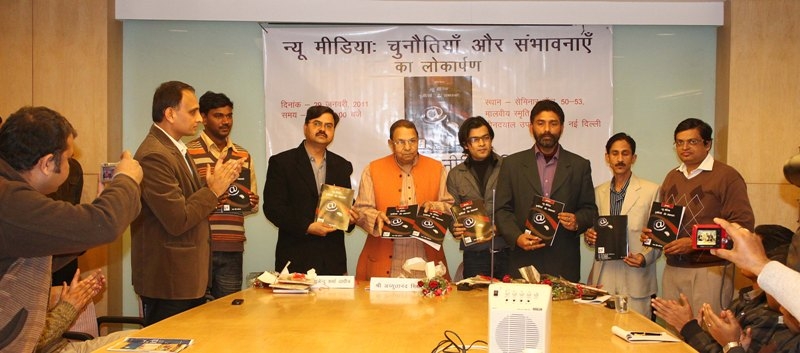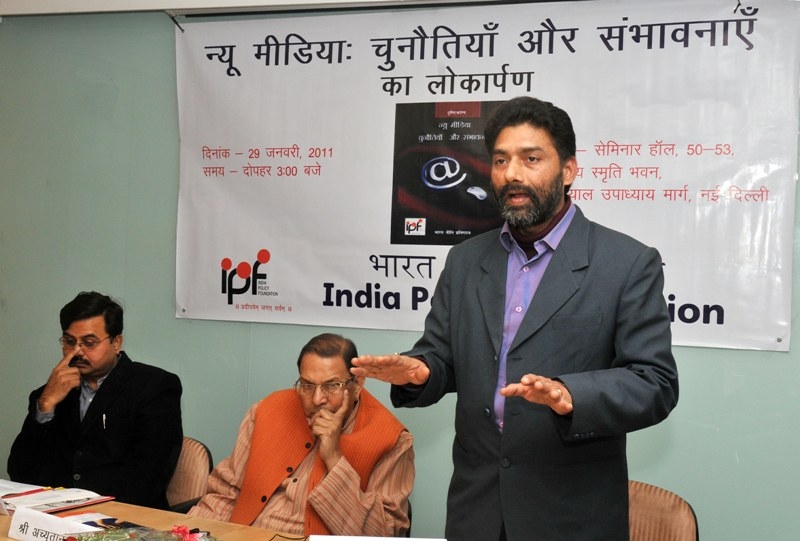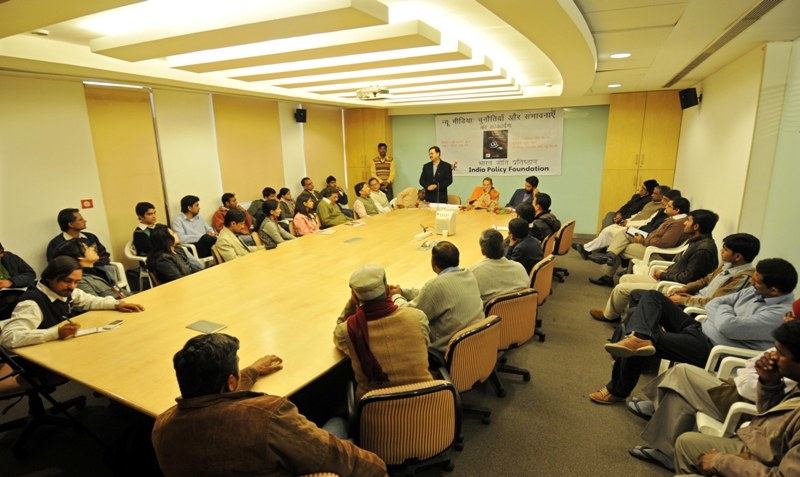New Media: Chunautiyan Aur Sambhavnayen
Total Views |

January 29, 2011, Malviya Smriti Bhawan
Released By: Shri A N Mishra, Former VC, Makhanlal Chaturvedi Patrakarita Vishwavidyalaya
Chief Guest: Onkareshwar Pandey, Executive Editor, Sunday Indian
Speakers: Balendu Sharma Dadhich, New Media Exponent and Group Editor of Prabha Sakshi
The close of the 20th century witnessed a great revolutionary change in global media scene and that was the emergence of New Media. This New Media is qualitatively different from the old or traditional media as it is interactive and more democratic in its very nature. New Media holds out a possibility of on-demand access to content anytime, anywhere, on any digital device, as well as interactive user feedback, creative participation and community formation around the media content. Another important promise of New Media is the “democratization” of the creation, publication, distribution and consumption of media content. These qualities have made it so popular in Western countries that it is now becoming a threat to the existence of the old media. New Media is now spreading its wings in developing countries like India. In India although it is growing at a tremendous pace, it still has some distance to go to be in a position to challenge the hold of the old media. But one thing is certain that it is making a strong impact on the media scene.
The India Policy Foundation organized two brainstorming sessions to take stock of this new, emerging media. The objective behind the brain-storming sessions was to explore its theoretical grounds so that it can play a critical and constructive role in a democratic space. Both discussions proved very thought-provoking and fruitful. Learned speakers brought out different aspects of New Media and underlined the fact that it is New Media which has given birth to true globalization. A consensus emerged during the discussion that although a business model could not be evolved for New Media, it is necessary to work towards one, so as to foster economic sustainability.The Foundation felt it necessary to make the content of the brainstorming sessions available to readers and therefore came up with the publication of the monograph on New Media titled, New Media: Challenges and Possibilities (New Media Chunautiya aur Sambhavanayen).

The monograph has insightful information and comments from experts in the field. The article of Balendu Dadhich analysized deals with the different contours of New Media. Satish Pednekar, editor of the monograph, underlines some negative effects of New Media such as the compulsive addiction of youth to the Media, stating that for escapist people who are unable to deal with the tensions of the real world, the virtual world of New Media is becoming a refuge.The monograph was published as a part of the series ‘Perspective’(Drishtikon). It contains the background, perspective, problems, challenges, possibilities and history of New Media which were discussed at two consecutive brainstorming sessions organized by the IPF. It carries the write-ups of four senior journalists - Rambahadur Rai, Satish Pednekar (editor of the monograph), Uday Sinha and Balendu Dadhich - dealing with various dimensions and theoretical aspects of New Media.

Initiating a debate, Prof Rakesh Sinha, Hon Director, IPF, said that the new technology heralded a new media which means communism of knowledge. Everyone has equal access to information and tools of knowledge. He said, “The objective behind the two brainstorming sessions and the publication on New Media is to explore its theoretical ground so that it can play critical and constructive role in a democratic space.”Onkareshwar Pandey, said that New Media has demolished the monopoly of elite, traditional capital-centric media houses and now it was impossible to suppress information, news and views. He suggested that the portals should concentrate on specific issues rather than becoming general in nature. Balendu Sharma Dadhich elaborated upon various dimensions and achievements of New Media. He pointed out that although a business model could not be evolved for the new media since the last one decade, it is necessary to work towards it so as to foster economic sustainability of the new medium. A N Mishra analyzed the role of media in various phases of modern Indian history. He observed that during the freedom movement, the existing media of that time set out its own parameters, moral ground and ethics, but today such principles are completely absent from the fora. He pointed out that the forces which control the politics and economy of the country have also put New Media under their clutches.